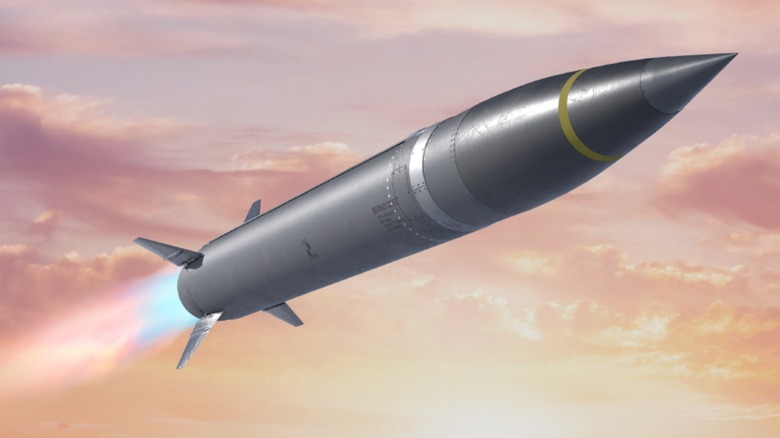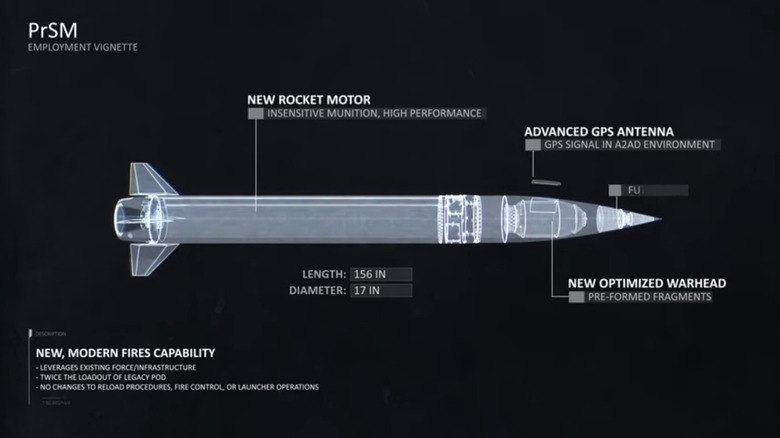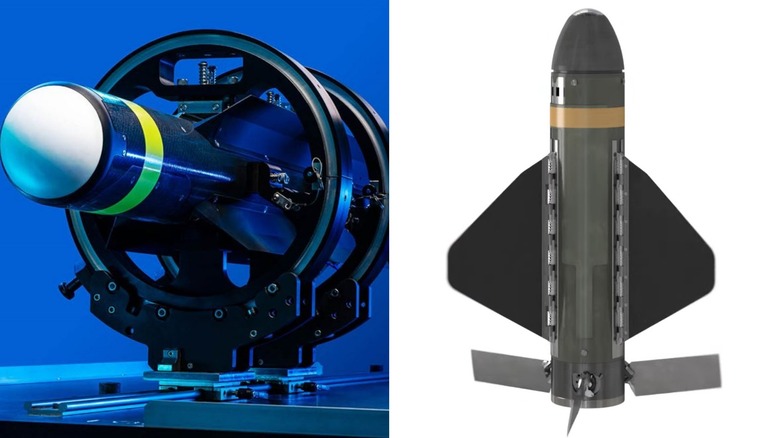Here's Why Lockheed Martin's New Precision Strike Missile Will Be An Absolute Game Changer
Due to the war in Ukraine, the MGM-140 Army Tactical Missile System (ATACMS) has recieved a lot of attention, but they've been around since the early 1990s, and a replacement is warranted. To that end, Lockheed Martin is developing a new system: the Precision Strike Missile (PrSM), and it's a game changer. The new missile being developed has several features that set it apart from the ATACMS and other short-range surface-to-surface missiles used by the U.S. Army.
The PrSM is compatible with Lockheed's MLRS M270, which is the launch platform for the High Mobility Artillery Rocket System (HIMARS), so replacing the ATACMS will be cost-effective and efficient. Most importantly, the PrSM is easily adaptable for use with a variety of warheads, and that's what makes it special because one such configuration allows for the deployment of submunitions. A submunition is any ordnance or device deployed from larger ordnance, but PrSM is not the same thing as something like a cluster bomb.
That type of ordnance releases hundreds of smaller bomblets, many of which become dangerous hazards long after a conflict ends. The PrSM is far more advanced and will be capable of deploying a variety of submunitions, but more importantly, it will be able to carry and release the Coyote Drone developed by Raytheon to engage multiple targets independently. Other configurations could employ Northrop Grumman's Hatchet miniature strike munition. These small bomblets are comparable to 500-pound bombs, so the PrSM's adaptability will make it suitable for a large range of military operations.
The Precision Strike Missile (PrSM)
The PrSM has a stated range of between 37 and 310+ miles, though its actual maximum range hasn't been divulged to the public. For guidance, it features an inertial navigation system with GPS, so it can recalculate its position as it relates to the target on the fly. It uses what Lockheed (PDF) calls an "Insensitive Munition (IM) propulsion system" and an IM energetic payload. The M270A2 is capable of carrying two PrSM in its launch pods, and because of that self-propelled artillery's high mobility, it can be situated almost anywhere the Army needs it to go for combat operations.
Each missile measures 13 feet long with a diameter of 17 inches. The warhead being developed by Lockheed is optimized to take out targets using preformed fragments. Instead of slamming into a target, the warhead detonates above it, sending a wide burst of fragments down toward anything from vehicles and buildings to personnel and naval vessels. The fragments work similarly to a fragmentation grenade, but instead of bursting out in a radial pattern, the missile's kinetic energy directs them with incredible force onto the target, destroying anything in their path.
This is the baseline warhead being developed for the PrSM by the defense contractor, and while it's highly lethal and effective in demonstrations, the benefit of including submunitions and uncrewed aerial vehicles (UAS) like the Coyote drone is undeniable. So-called "swarming munitions" will take what is already a deadly missile and transform it into a variable killing machine unlike anything previously deployed in warfare.
The Coyote drone and Hatchet bomblet
While it's unclear how many Coyote drones or Hatchet bomblets will fit within a PrSM, the effectiveness of these devices suggests any number will exponentially improve the missile's lethality. Coyote drones are compact devices initially designed as counter-UAS (C-UAS) vehicles that could locate, target, and destroy enemy UAS within their range. They also have communications, precision strike, electronic warfare, and reconnaissance capabilities, so lethality isn't necessarily the only option available to the Coyote.
Theoretically, a missile loaded with Coyotes could be fired and deployed well beyond their range to engage multiple targets in a variety of ways. The Hatchet miniature precision strike munition features an enhanced warhead that, despite weighing only 3.2 pounds, has the explosive power comparable to between 45 and 80% that of a 500-pound Bomb. They are also accurate to within 6.5 feet, making them more than capable of striking an enemy vehicle or building.
They are also scalable to limit collateral damage and feature a modular design, so variants can be employed for a variety of mission requirements. A PrSM carrying Hatchets could launch to a target area and deploy them high above a designated location. The bomblets could then fly toward a series of different targets on the ground, expanding the overall lethality of the prism, which would still be a lethal missile in and of itself. Together, the PrSM, Hatchet, and Coyote represent a leap forward in offensive missile technology and could pave the way for future ordnance of similar scale and scope.


